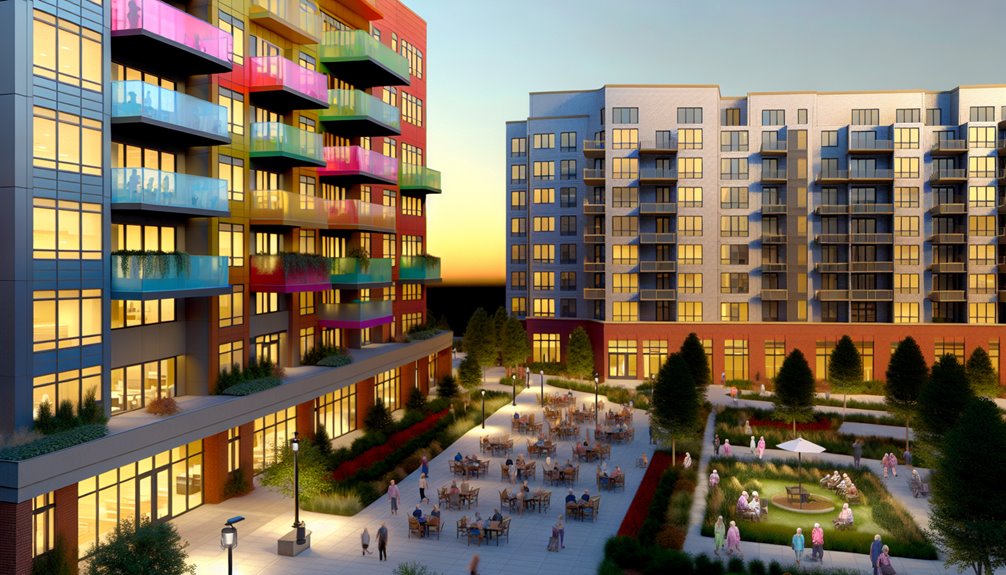When deciding between multifamily and senior living investments, consider senior living’s economic resilience. Unlike multifamily, senior living is recession-resistant and benefits from a growing demand fueled by an aging population. With cap rates of 8.5% to 9.5%, senior living often outperforms multifamily’s 6%. Operating costs are higher, yet cash flow remains stable. Technological advancements further enhance senior living’s appeal. Discover how these factors offer secure and potentially lucrative investment opportunities in senior living.
Key Takeaways
- Senior living offers higher cap rates (8.5%-9.5%) compared to multifamily (6%), indicating potentially greater returns.
- Economic downturns have less impact on senior housing due to its recession-resistant model.
- Aging population ensures growing demand for senior living, supporting stable occupancy and cash flow.
- Multifamily properties have shorter lease-up periods but may experience more occupancy fluctuations than senior living.
- Senior living projects often outperform multifamily in net operating income and internal rate of return.
Economic Resilience of Senior Living Investments
Although economic downturns can shake many sectors, senior living investments stand out for their resilience. In the senior housing market, investment opportunities are bolstered by a recession-resistant model that guarantees stable cash flow even during economic instability. Historical data shows less fluctuation in occupancy rates, making these investments less volatile than multifamily properties. The aging population spurs demographic shifts, creating a growing demand for senior living facilities. With over 10,000 Americans turning 65 daily, this demographic trend supports long-term growth in the sector. Significantly, senior care projects offer cap rates ranging from 8.5% to 9.5%, indicating potential for higher returns. The substantial investment gap of approximately $298 billion by 2030 highlights the urgency and potential of this market. Moreover, investments in senior living communities boost local economies by creating jobs and increasing tax revenue.
Demographic Trends Driving Senior Housing Demand
As the population aged 65 and older swells to an estimated 83.9 million by 2050, the demand for senior housing intensifies. This demographic shift is largely driven by the aging Baby Boomer population, with over 10,000 Americans turning 65 each day. As the wealthiest generation in history, Boomers seek supportive living arrangements that offer both accessibility and independence. Consequently, the demand for senior housing communities is skyrocketing. By 2040, the U.S. will need over $1 trillion in inventory for the 80+ age group, underscoring a significant gap between supply and demand. This burgeoning market presents a compelling investment opportunity, as the senior age cohort is projected to grow faster than the general population, ensuring a growing demand for senior living solutions. Additionally, the surging demand driven by the aging baby boomer population ensures stable and growing market conditions for investors in senior housing.
Financial Performance and Revenue Streams
The demographic momentum driving senior housing demand sets the stage for evaluating the financial performance and revenue streams of these investments. In the senior living industry, projects often outperform similar-sized multifamily properties in net operating income and internal rate of return, despite higher operating costs of 35-40%. Assisted living and memory care facilities contribute to cash flow stability through consistent revenue streams, thanks to their diverse service offerings. Senior care projects exhibit cap rates of 8.5-9.5%, surpassing the 6% typical for multifamily properties. Additionally, the sector’s needs-based model guarantees resilience during economic downturns, unlike market-rate housing. However, investors should note that senior housing requires longer lease-up periods of 18-24 months compared to multifamily’s 6-12 months. Furthermore, the 80-plus age group is projected to grow annually, further increasing the demand for senior living facilities and enhancing their financial potential.
Innovation and Technological Integration in Senior Living
In recent years, senior living has seen a surge in technological integration, fundamentally transforming both operational efficiencies and resident experiences. Senior housing providers are leveraging technology to reduce healthcare costs and enhance quality of life. Telehealth services facilitate remote monitoring, enabling early health concern identification. The aging population benefits from smart home technology that promotes safety and independence, making active adult rentals more attractive. Additionally, technology-driven amenities like fitness tracking and social platforms encourage community engagement and cater to seniors’ active lifestyles. The collaboration across technology, healthcare, and construction industries is fostering innovations that meet the unique needs of senior living. These advancements not only improve day-to-day living but also position senior housing as a forward-thinking investment opportunity. Moreover, the integration of sustainable technology is a key trend shaping senior living design in 2024, further enhancing the appeal for investors.
Market Risks and Risk Management Strategies
While economic uncertainty often casts a shadow over real estate investments, Senior Care projects exhibit resilience due to their needs-based nature. Unlike multifamily housing, senior housing maintains higher occupancy rates and consistent cash flow during downturns, bolstering financial stability. Real estate investors benefit from cap rates ranging from 8.5-9.5%, exceeding the typical 6% for multifamily housing, indicating a potential for higher returns. Access to low-cost, long-term financing from Fannie Mae, Freddie Mac, and HUD further mitigates market risks, providing a safety net against rising debt rates. However, effective operator selection remains critical, as operational performance directly impacts revenue and investment stability. By prioritizing these strategies, you can navigate market risks effectively, ensuring robust returns in senior housing investments. Additionally, investing in senior living offers exclusive investment opportunities, which can enhance overall portfolio diversification and returns.
Conclusion
When you weigh multifamily against senior living investments, imagine a sturdy ship steering through the economic seas. Senior living stands resilient, buoyed by an aging population like an ever-swelling tide. Revenue streams flow steadily, fortified by technological advancements that enhance care. Yet, caution is essential; market risks loom like hidden icebergs. By employing effective risk management strategies, you can harness these demographic winds, steering towards a future ripe with opportunity and stability.

